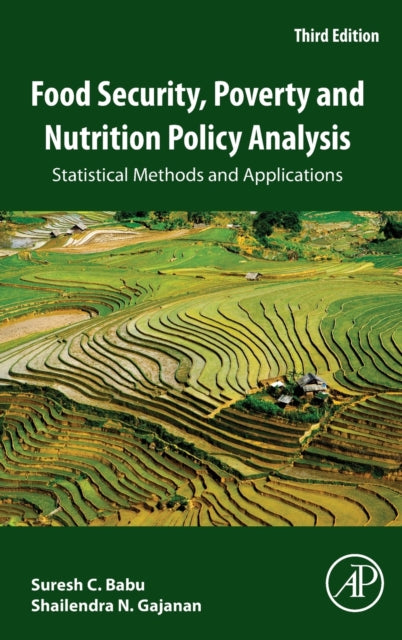SureshBabu,ShailendraGajanan
Food Security, Poverty and Nutrition Policy Analysis: Statistical Methods and Applications
Food Security, Poverty and Nutrition Policy Analysis: Statistical Methods and Applications
- Condition: Brand new
- UK Delivery times: Usually arrives within 2 - 3 working days
- UK Shipping: Fee starts at £2.39. Subject to product weight & dimension
Bulk ordering. Want 15 or more copies? Get a personalised quote and bigger discounts. Learn more about bulk orders.
Couldn't load pickup availability
- More about Food Security, Poverty and Nutrition Policy Analysis: Statistical Methods and Applications
Food Security,Poverty and Nutrition Policy Analysis: Statistical Methods and Applications,Third Edition combines statistical data analysis and computer literacy to develop policy alternatives for food insecurity,malnutrition, and poverty. It presents the latest uses of statistical methods in R and includes new datasets on obesity. It also offers program evaluation methods for testing policy interventions.
Format: Hardback
Length: 786 pages
Publication date: 22 September 2021
Publisher: Elsevier Science Publishing Co Inc
Food Security, Poverty, and Nutrition Policy Analysis: Statistical Methods and Applications, Third Edition is a comprehensive guide that combines statistical data analysis and computer literacy to address real-world food insecurity, malnutrition, and poverty problems. The book presents the latest uses of statistical methods for policy analysis, utilizing the open-source statistical environment R, along with original Stata files and applications. Additionally, a new chapter on obesity introduces new datasets for analysis, demonstrating their effectiveness in addressing policy issues. Furthermore, program evaluation methods are included, directly applicable to data on food security, nutrition, poverty indicators, and causal factors. This unique, real-world data offers a hands-on approach to econometric practice, allowing readers to test the effects of policy and program interventions. Moreover, this is the first book to explore actual data using STATA and R statistical packages, providing a line-by-line guide to programming and interpreting results.
The book is organized into five chapters, each covering a specific aspect of statistical methods and applications. Chapter 1 provides an introduction to statistical methods and their role in policy analysis. It discusses the importance of data, hypothesis testing, and the use of statistical models to address policy questions. Chapter 2 focuses on descriptive statistics, including measures of central tendency, dispersion, and correlation, and their application in understanding food security, poverty, and nutrition problems. Chapter 3 introduces inferential statistics, including hypothesis testing and regression analysis, and their use in identifying relationships between variables and developing policy interventions. Chapter 4 explores the use of statistical software, such as R and STATA, for data analysis and visualization. It provides a step-by-step guide to programming and interpreting results, including examples and exercises to reinforce learning. Chapter 5 discusses the application of statistical methods to specific policy issues, such as food insecurity, malnutrition, and poverty. It includes case studies and examples from different regions of the world to illustrate the practical implications of statistical analysis in policymaking.
One of the key strengths of this book is its comprehensive coverage of statistical methods and their applications to food security, poverty, and nutrition policy analysis. The authors have drawn on their extensive experience in the field to provide a practical and accessible guide for both researchers and policymakers. The book is well-organized, with clear explanations and examples that make complex statistical concepts accessible to a wide range of readers. Additionally, the use of real-world data and case studies provides a practical perspective on the challenges and opportunities associated with addressing food insecurity, malnutrition, and poverty.
Another notable feature of the book is its emphasis on computer literacy and the use of statistical software. The authors have provided detailed instructions on how to use R and STATA, two widely-used statistical software packages, and have included original Stata files and applications to facilitate learning. This approach not only enhances the book's practicality but also allows readers to apply the statistical methods learned to their own research and policy analysis.
Furthermore, the book's inclusion of program evaluation methods is particularly valuable. These methods allow policymakers to assess the effectiveness in addressing food insecurity, malnutrition, and poverty problems and make informed decisions about resource allocation. The authors have provided a comprehensive guide to program evaluation, including the development of evaluation frameworks, data collection and analysis, and the interpretation of results. This approach ensures that policymakers can effectively evaluate the impact of their policies and programs and make necessary adjustments to improve outcomes.
In conclusion, Food Security, Poverty, and Nutrition Policy Analysis: Statistical Methods and Applications, Third Edition is a comprehensive and practical guide that combines statistical data analysis and computer literacy to address real-world food insecurity, malnutrition, and poverty problems. The book's comprehensive coverage of statistical methods, real-world data, and practical applications make it an invaluable resource for researchers, policymakers, and practitioners in the field. Its emphasis on computer literacy and program evaluation methods ensures that readers have the skills and knowledge necessary to effectively address these complex issues and make a positive impact on the lives of individuals and communities around the world.
Weight: 450g
Dimension: 229 x 152 (mm)
ISBN-13: 9780128204771
Edition number: 3 ed
This item can be found in:
UK and International shipping information
UK and International shipping information
UK Delivery and returns information:
- Delivery within 2 - 3 days when ordering in the UK.
- Shipping fee for UK customers from £2.39. Fully tracked shipping service available.
- Returns policy: Return within 30 days of receipt for full refund.
International deliveries:
Shulph Ink now ships to Australia, Belgium, Canada, France, Germany, Ireland, Italy, India, Luxembourg Saudi Arabia, Singapore, Spain, Netherlands, New Zealand, United Arab Emirates, United States of America.
- Delivery times: within 5 - 10 days for international orders.
- Shipping fee: charges vary for overseas orders. Only tracked services are available for most international orders. Some countries have untracked shipping options.
- Customs charges: If ordering to addresses outside the United Kingdom, you may or may not incur additional customs and duties fees during local delivery.


